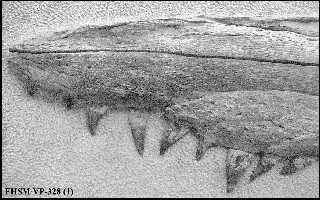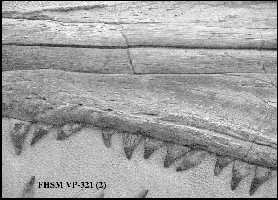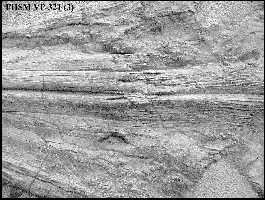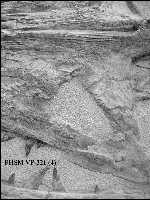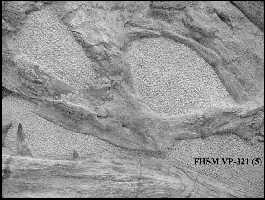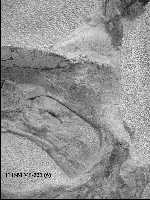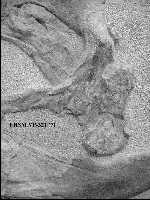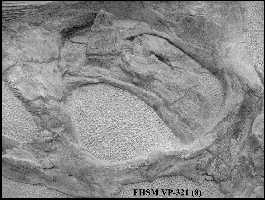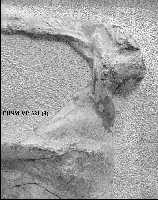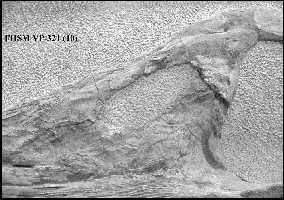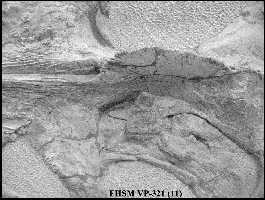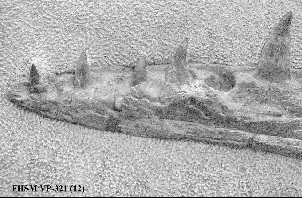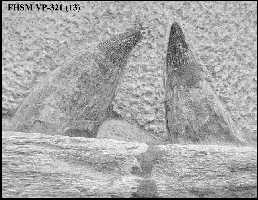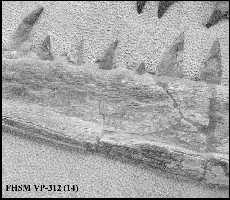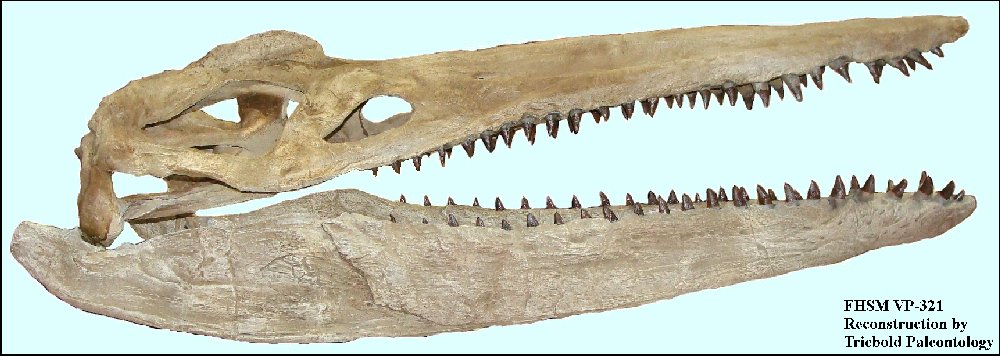 |
The skull of Megacephalosaurus
eulerti
Schumacher, Carpenter and Everhart 2013
(formerly Brachauchenius
lucasi Williston 1903)
A photographic atlas of FHSM VP-321
Copyright © 2002-2014 by Mike
Everhart
Page created 11/30/2002; revised 01/07/2014
LEFT: The skull of Megacephalosaurus
eulerti (FHSM VP-321 reconstructed by Triebold Paleontology Inc and displayed
at the 2012 meeting of the Society of Vertebrate Paleontology. |
Until recently the only pliosaur recognized from Kansas
was Brachauchenius
lucasi Williston 1903. A few fragmentary specimens suggest other species may be
present. In Kansas, these short-necked pliosaurs are relatively rare in the Greenhorn
Limestone and Carlile Shale, but are represented by two excellent specimens, the largest
of which is on exhibit at the Sternberg Museum of Natural History.
The FHSM VP-321 specimen was found on June 5, 1950 by Robert and Frank Jennrich while hunting sharks
teeth in the Fairport Chalk of Russell County. It was collected by G. F. Sternberg in
October, 1950,, with the help of the Jennrich brothers. The lower jaw is 68 inches
(170 cm) long.
Schumacher, B.A., Carpenter, K. and
Everhart, M.J. 2013. A new Cretaceous Pliosaurid (Reptilia, Plesiosauria) from
the Carlile Shale (middle Turonian) of Russell County, Kansas, Journal of
Vertebrate Paleontology 33(3):613-628.
See these other webpages: Pliosaurs and
Polycotylids and Kronosaurus for more
information.
In April, 2011, a full size
reconstruction of Megacephalosaurus eulerti was mounted in the entry of the
Sternberg Museum.
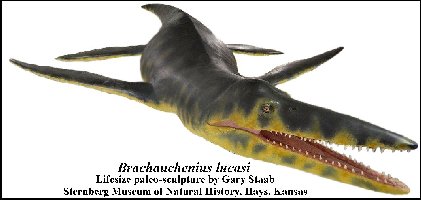 |
LEFT: The Sternberg Museum of Natural History has
recently added the exhibit of a life-size sculpture of the Late Cretaceous
pliosaur, Megacephalosaurus eulerti, created by master paleo-artist
Gary Staab (Staab Studios). The full size reconstruction was based on the 5 ft long skull
(FHSM VP-321) collected by G.F Sternberg in 1950 from the Fairport Chalk
of Russell County, Kansas. Photos are copyright by Gary Staab and used
here with his generous permission.
RIGHT: Megacephalosaurus eulerti in right lateral view in the
entry area of the Sternberg Museum. The reconstruction is 23 ft (7 m) long
and about 16 ft (4.8 m) wide across the paddles. |
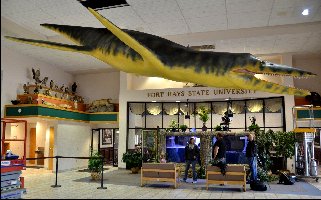 |
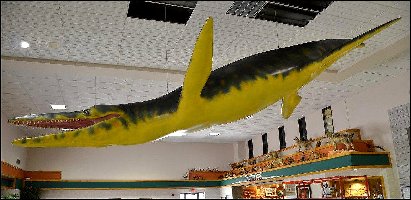 |
LEFT: Megacephalosaurus eulerti reconstruction in left
lateral view.
RIGHT: A young visitor thinks he's about to become a snack for a
giant pliosaur. Here's looking at
you! |
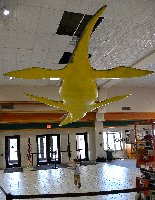 |
 |
LEFT: A head-on view of Megacephalosaurus eulerti;
possibly the last thing that many of his prey items would have seen.
RIGHT: The scale of this beast is hard to gauge in the previous
pictures, but this photo with its creator, Gary Staab, pretty much tells
the story. (Staab Studios) Bruce Schumacher, Ken Carpenter and Mike Everhart
provided technical assistance on the reconstruction. |
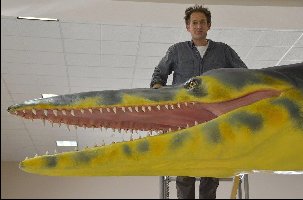 |
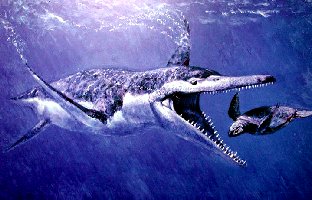 |
LEFT: Somewhere in the Western Interior Sea, a giant
pliosaur (Megacephalosaurus eulerti) is about to make lunch out of a small turtle
similar to Desmatochelys. Megacephalosaurus
was one of the last of the pliosaurs and made it's final appearance in Kansas during the
deposition of the Blue Hill Shale Member (Middle Turonian) of the Carlile Shale. Varner
painting courtesy of the Museum of Northern Arizona.
RIGHT: "Brachauchenius and
Squid" from a painting done for Pete Von Sholly. This picture
recreates a specimen found in the Turner Sandy Member of the Carlile Shale
Formation (Turonian / Late Cretaceous) near Edgemont, South Dakota. This
was the latest age that these giant pliosaurs were found in North
America.... coincidentally the same time that mosasaurs first appeared. |
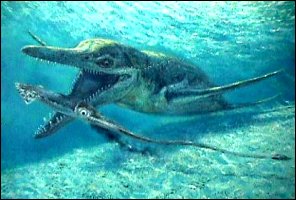 |
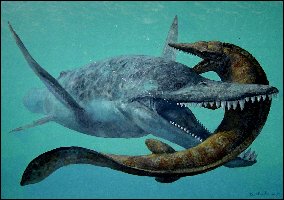 |
LEFT: Oil
painting by Daniel W. Varner, 1989, titled “Shootout in
Topeka
” by the owner. Michael W. Greenwald. This painting recreates a possible
encounter that may have taken place in the Western Interior Seaway over
Kansas between one of last of the pliosaurs and the earliest
mosasaurs. |
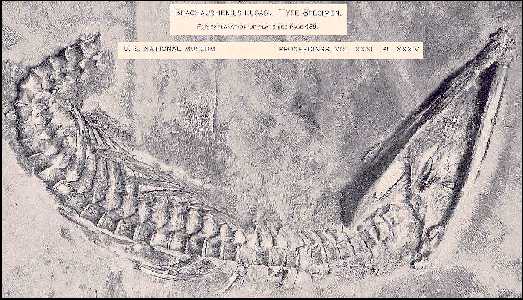 |
LEFT: Brachauchenius lucasi Williston was the
only genus of pliosaurs known from Kansas. The holotype (USNM 4989) was collected from the
"Benton Formation" in Ottawa County, Kansas, by Charles H. Sternberg in the
spring of 1884 while working for O.C. Marsh (Everhart, 2007), and described by S.W.
Williston in 1903. The skull was originally mounted as discovered, upside-down, with
37 vertebrae. Skull length is 90 cm (Williston, 1907). Click here for Williston's drawing of the reconstruction
skull of the holotype specimen. From the notes C. H. Sternberg sent
to O.C. Marsh, "It is well preserved as far as
it goes but only 12+ feet are preserved. The under jaws are 49 in. long. The spread of
them at the distal end [is] 14 inches. Most of the cervical vertebrae are present."
and "Under jaw fifty inches, nineteen inches between branches, nearly perfect
cervicals present, good, [limbs] gone, few dorsals." The specimen and the slab that contained it weighted 1370 pounds
when shipped to Marsh. |
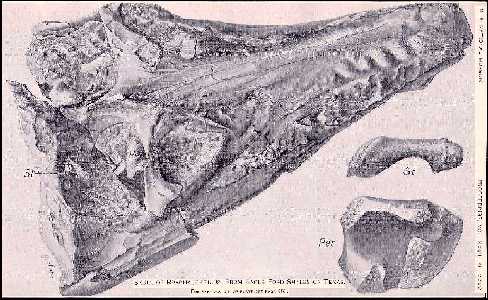 |
LEFT: A second specimen (USNM 2361, LEFT) was collected from the
Eagle Ford Formation, on Bouldin Creek near Austin, Texas, and described by Williston in
1907. Skull length is 80 cm (Williston, 1907).
SYSTEMATIC PALEONTOLOGY
Order Plesiosauria, de Blainville 1835
Superfamily Plesiosauroidea, Welles 1943
Family Brachaucheniidae Williston 1925
Genus Brachauchenius lucasi Williston 1903 |
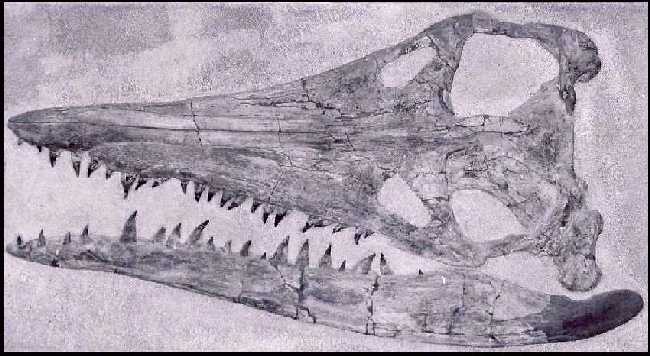 |
LEFT: The skull of a second genus and
specie (Megacephalosaurus eulerti - FHSM VP
321) shown in left dorso-lateral view, is much larger, more
complete, and somewhat better preserved than either of the two earlier specimens. It was
collected by George Sternberg in October, 1950, from the Fairport Chalk Member of the
Carlile Shale (Middle Turonian) near the town of Fairport in northwest Russell County,
Kansas.
A a larger, but fragmentary specimen preserving just the front
of the skull ahead of the eye sockets is in the collections of the University
of Nebraska State Museum (below) |
The skull of VP-321 is on exhibit in the Sternberg
Museum of Natural History at Fort Hays State University. A cast of the skull is
also on display at the University of Kansas Museum
of Natural History, Lawrence, Kansas. This skull is about five feet (152 cm) in length
along the mid-line, and must have come from a large bodied animal that is estimated to
have been at least 7 m (22 ft) long. Williston (1907) and Carpenter (1996) agree that Brachauchenius
is closely related to the Jurassic pliosaur, Liopleurodon ferox.
| Additional Megacephalosaurus eulerti
remains, including a partial
skull, have been collected in Russell County (see "FHSM (unnumbered)" in
Schwimmer, et al., 1997, Table 1; J. D. Stewart, pers. comm., 1999) but have not yet been
officially described. |
Click on the pictures below to see details of skull of FHSM VP-321:
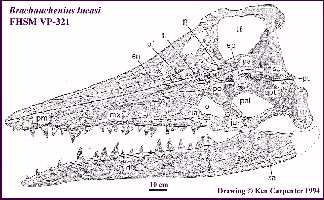 |
The figure at LEFT is from a 1994 draft of Carpenter (1996) and is
copyright © by Kenneth Carpenter; used with permission of Kenneth Carpenter. CLICK TO
ENLARGE. Key to bones of the skull and lower jaw of Megacephalosaurus
eulerti: d - dentary; ep - epipterygoid; fr - frontal; ju -
jugal; mx maxilla; o - orbit; p - pineal foramen; pa - parietal; pal - palatine; pf -
prefrontal; pm - premaxilla; pt - pterygoid; en - external nares; q - quadrate; qpt -
quadrate ramus of pterygoid; sa - surangular; sq -squamosal; tf - temporal fenestra |
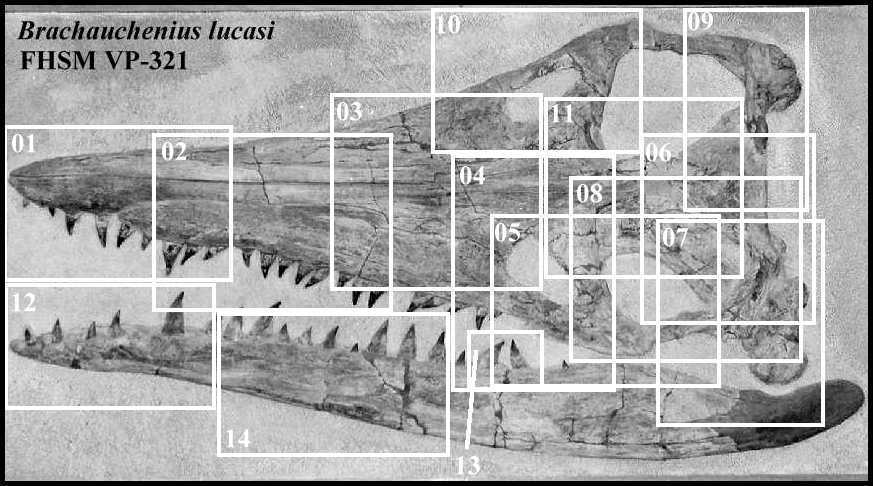
 |
LEFT: The right lower jaw in medial view, anterior to the left.
The right dentary was lying across and on top of the skull when discovered and is not
included in the exhibit mounting. |
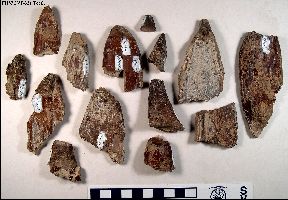 |
LEFT: Fragments of teeth collected in association with VP-321.
Many of the teeth were found loose, scattered around the skull and lower jaws. |
 |
LEFT: A partial skull of a Megacephalosaurus eulerti
(UNSM 50136)
specimen from an unknown locality in the collection of the University of Nebraska. The
specimen is somewhat larger then FHSM VP-321, but similar in preservation to FHSM VP-321.
(Schumacher, 2008) RIGHT: A portion of the skull and a jaw with teeth of another
possible Megacephalosaurus eulerti specimen (UNSM 112437) that was discovered in the Graneros Shale during the
construction of the Glen Elder Dam in Mitchell County. Possibly the oldest known specimen
of this genus/species. Specimen is in the collection of the University of Nebraska State
Museum. |
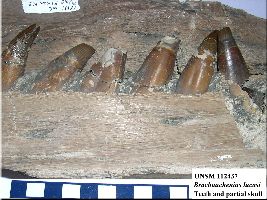 |
References:
Carpenter,
K. 1996. A review of the short-necked plesiosaurs from the Cretaceous of the Western
Interior, North America. Nues Jahrbuch für Geologie und Paläontologie, Abhandlungen,
(Stuttgart), 201(2):259-287.
Everhart, M. J. 2007. Historical note on the 1884 discovery of Brachauchenius
lucasi (Plesiosauria; Pliosauridae) in Ottawa County, Kansas. Kansas
Academy of Science, Transactions 110(3-4):255-258.
Lucas, F. A. 1903. A new plesiosaur.
Smithsonian Miscellaneous Collections 45:96, pl. XXVIII (Quarterly Issue Vol. 1), 1457.
Schumacher, B. A. 2008. On a pliosaur skull (Plesiosauria) from the Upper
Cretaceous of the North American Western Interior. Kansas Academy of Science, Abstracts of
the 140th Annual Meeting, Transactions 111(1/2):186.
Schumacher, B.A., Carpenter, K. and Everhart, M.J. 2012. A new pliosaur
(Plesiosauria, Pliosauridae) from the Carlile Shale (Cretaceous, Middle
Turonian) of Russell County, Kansas. Supplement to the online Journal of
Vertebrate Paleontology ISSN 1937-2809, pp.
168-169.
Schumacher, B.A., Carpenter, K. and
Everhart, M.J. 2013. A new Cretaceous Pliosaurid (Reptilia, Plesiosauria) from
the Carlile Shale (middle Turonian) of Russell County, Kansas, Journal of
Vertebrate Paleontology 33(3):613-628
Schumacher, B.A. and M. J. Everhart. 2005. A stratigraphic and taxonomic
review of plesiosaurs from the old “Fort Benton Group” of central Kansas: A new
assessment of old records. Paludicola 5(2): 33-54.
Schwimmer, D. R., J.D. Stewart, and G. D. Williams. 1997. Scavenging by sharks of the
genus Squalicorax in the late Cretaceous of North America. PALAIOS, 12:71-83.
Williston, S. W. 1903. North American plesiosaurs, Field
Columbian Museum, Pub. 73, Geological Series, 2(1):1-79, 29 plates.
Williston, S. W. 1907. The skull of Brachauchenius, with special
observations on the relationships of the plesiosaurs. United States National Museum
Proceedings 32:477-489. pls. 34-37.
















